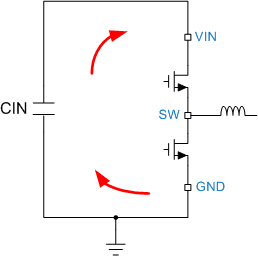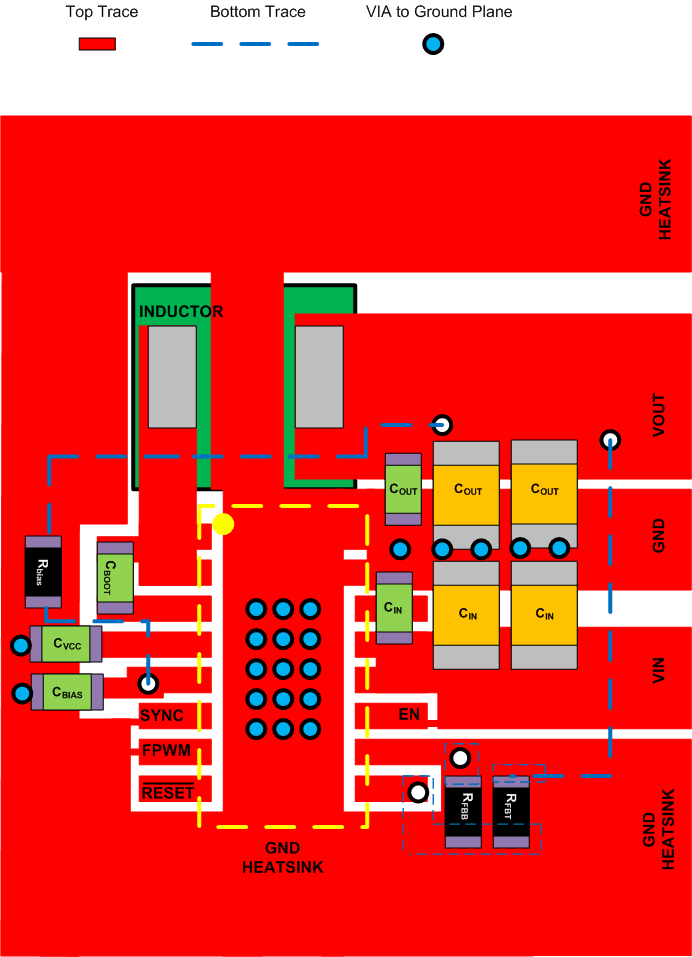JAJSCV5 November 2016 LM53602 , LM53603
PRODUCTION DATA.
- 1 特長
- 2 アプリケーション
- 3 概要
- 4 改訂履歴
- 5 Device Comparison Table
- 6 Pin Configuration and Functions
- 7 Specifications
- 8 Detailed Description
- 9 Application and Implementation
- 10Power Supply Recommendations
- 11Layout
- 12デバイスおよびドキュメントのサポート
- 13メカニカル、パッケージ、および注文情報
11 Layout
11.1 Layout Guidelines
The PCB layout of any DC-DC converter is critical to the optimal performance of the design. Bad PCB layout can disrupt the operation of an otherwise good schematic design. Even if the converter regulates correctly, bad PCB layout can mean the difference between a robust design and one that cannot be mass produced. Furthermore, the EMI performance of the regulator is dependent on the PCB layout, to a great extent. In a buck converter, the most critical PCB feature is the loop formed by the input capacitor and power ground, as shown in Figure 46. This loop carries fast transient currents that can cause large transient voltages when reacting with the trace inductance. These unwanted transient voltages disrupt the proper operation of the converter. Because of this, the traces in this loop should be wide and short, and the loop area as small as possible to reduce the parasitic inductance. Figure 47 shows a recommended layout for the critical components of the LM53603. This PCB layout is a good guide for any specific application. The following important guidelines must also be followed:
- Place the input capacitor(s) CIN as close as possible to the VIN and PGND terminals. VIN and GND are on the same side of the device, simplifying the input capacitor placement.
- Place bypass capacitors for VCC and BIAS close to their respective pins. These components must be placed close to the device and routed with short and wide traces to the pins and ground. The trace from BIAS to VOUT should be ≥10 mils wide. BIAS and VCC capacitors must be place within 4 mm of the BIAS and VCC pin (160 mils) .
- Use wide traces for the CBOOT capacitor. CBOOT must be placed close to the device with short and wide traces to the CBOOT and SW pins.
- Place the feedback divider as close as possible to the FB pin on the device. If a feedback divider and CFF are used, they must be close to the device while the length of the trace from VOUT to the divider can be somewhat longer. However, this latter trace must not be routed near any noise sources that can capacitively couple to the FB input.
- Use at least one ground plane in one of the middle layers. This plane acts as a noise shield and also act as a heat dissipation path.
- Connect the EP pad to the GND plane. This pad acts as a heat sink connection and a ground connection for the regulator. It must be solidly connected to a ground plane. The integrity of this connection has a direct bearing on the effective RθJA.
- Provide wide paths for VIN, VOUT and GND. Making these paths as wide as possible reduces any voltage drops on the input or output paths of the converter and maximizes efficiency.
- Provide enough PCB area for proper heat sinking. As stated in the Maximum Ambient Temperature section, enough copper area must be used to ensures a low RθJA, commensurate with the maximum load current and ambient temperature. The top and bottom PCB layers must be made with two ounce copper; and no less than one ounce. Use an array of heat sinking vias to connect the exposed pad (EP) to the ground plane on the bottom PCB layer. If the PCB has multiple copper layers (recommended), these thermal vias can also be connected to the inner layer heat-spreading ground planes.
- Keep switch area small. The copper area connecting the SW pin to the inductor must be kept as short and wide as possible. At the same time the total area of this node must be minimized to help mitigate radiated EMI.
- These resources provide additional important guidelines:
 Figure 46. Current Loops With Fast Transients
Figure 46. Current Loops With Fast Transients
11.1.1 Ground and Thermal Plane Considerations
As mentioned in the Layout Guidelines, TI recommends using one of the middle layers as a solid ground plane. A ground plane provides shielding for sensitive circuits and traces. It also provides a quiet reference potential for the control circuitry. The AGND and PGND pins must be connected to the ground plane using vias right next to the bypass capacitors. PGND pins are connected to the source of the internal low-side MOSFET switch. They must be connected directly to the grounds of the input and output capacitors. The PGND net contains noise at the switching frequency and may bounce due to load variations. The PGND trace, as well as PVIN and SW traces, must be constrained to one side of the ground plane. The other side of the ground plane contains much less noise and must be used for sensitive routes.
TI recommends providing adequate device heat sinking by using the exposed pad (EP) of the IC as the primary thermal path. Use a minimum 4 × 4 array of 10-mil thermal vias to connect the EP to the system ground plane for heat sinking. The vias must be evenly distributed under the exposed pad. Use as much copper as possible for system ground plane on the top and bottom layers for the best heat dissipation. TI recommends using a four-layer board with the copper thickness, starting from the top, as: 2 oz. / 1 oz. / 1 oz. / 2 oz. A four-layer board with enough copper thickness and proper layout provides low current conduction impedance, proper shielding and lower thermal resistance.
These resources provide additional important guidelines for thermal PCB design:
- AN-2020 Thermal Design By Insight, Not Hindsight (SNVA419)
- AN-1520 A Guide to Board Layout for Best Thermal Resistance for Exposed Pad Packages (SNVA183)
- Semiconductor and IC Package Thermal Metrics (SPRA953)
- Thermal Design made Simple with LM43603 and LM43602 (SNVA719)
- PowerPAD™ Thermally Enhanced Package (SLMA002)
- PowerPAD Made Easy (SLMA004)
- Using New Thermal Metrics (SBVA025)
11.2 Layout Example
 Figure 47. PCB Layout Example
Figure 47. PCB Layout Example